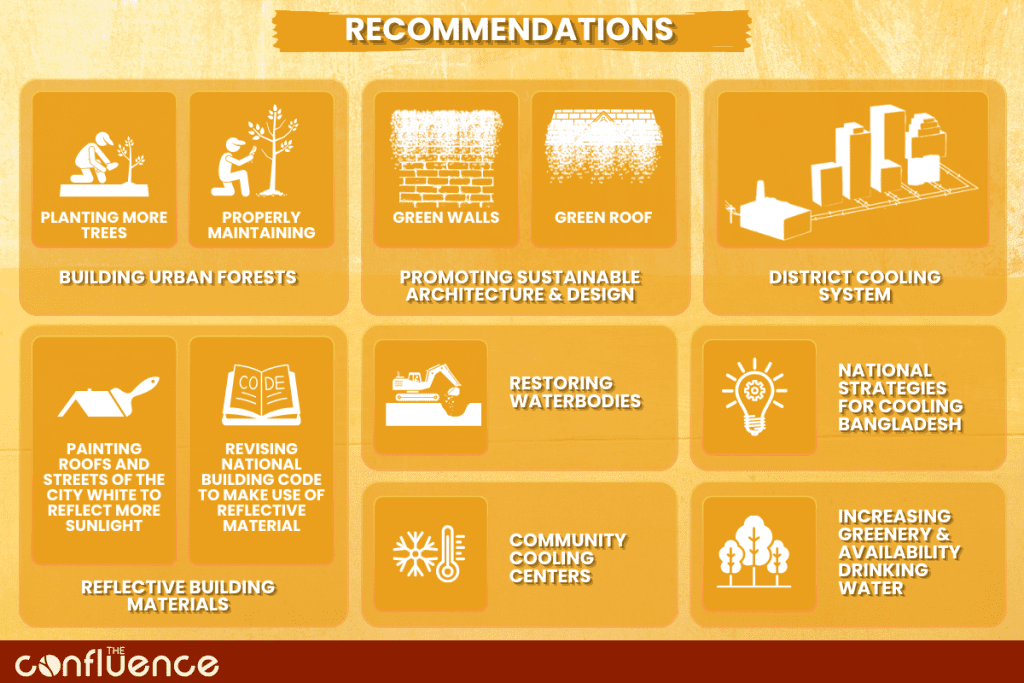As Dhaka sees the longest spell of heat waves in the record, the necessary question we should ask is how have we turned Dhaka into a heat island and how to get rid of it?
On April 20, 2024, the authorities in Bangladesh decided to shut down all schools, and other educational institutions due to the ongoing heatwave jeopardizing lives of the country’s inhabitants. Amidst the recent heat waves in Bangladesh, as per the media reports, as of now around 8 people have died due to extreme heat. Around 1,430 elderly, aged 65 and above have died between 2017 and 2021 from heat-related causes.
0
Dhaka’s rank out of 173 cities in annual liveability index
According to the Economist Intelligence Unit’s annual liveability index, Bangladesh’s capital ranks 166 out of 173 cities, making Dhaka the seventh least livable city in the world. This article looks into what Dhaka and other cities of Bangladesh are doing wrong when it comes to tackling heatwaves and how Bangladesh can draw inspiration from other cities who are keeping themselves cool!
“This is the first time Bangladesh has experienced a heatwave [spell] lasting for 26 consecutive days since we began recording them in 1948.”
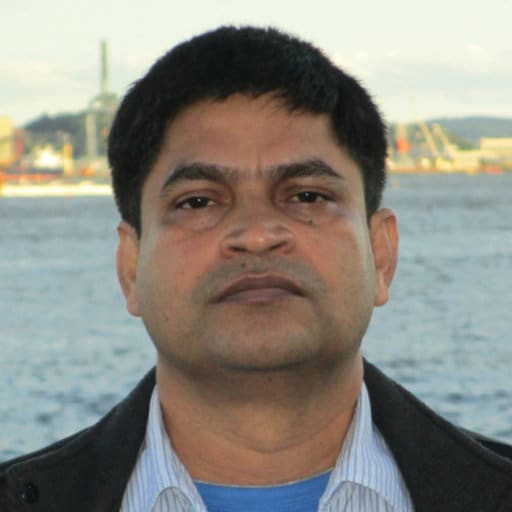
Muhammad Abul Kalam Mallik
Meteorologist, Bangladesh Meteorological Department
High temperatures, coupled with humidity make the cities of Bangladesh unlivable for its residents.
Inequality of Heatwaves
Such extreme heatwave spells are extremely unfair to the poorest and disadvantaged segments of the country as these underprivileged people suffer disproportionately from heatwaves. People who come from privileged backgrounds or have high-paying jobs can access air-conditioners (AC). Most of these privileged individuals have ACs in their homes and offices. On the flip side, the heatwaves disproportionately expose the low and low-middle income class to agony as they fail to pay for expensive air cooling appliances.
From rickshaw pullers, van drivers to construction workers, and garments workers, adequate air conditioning is non-existent as they work in places that often do not contain such facilities. A rickshaw puller drives their rickshaw all day in extreme heat just to earn their livelihood. Individuals whose professions are based on the streets of our cities have to operate and work under the extreme sunlight all day long.
The poorest areas and neighborhoods of our cities witness the highest concentration of heat. For instance, in Kamrangirchar, temperatures usually remain 12°C higher than other surroundings of Dhaka. This is because the large number of informal settlements in Kamrangirchar widely used corrugated iron sheet roofing that traps the heat and makes the area warmer.
Avg. +
0
°C
Temperature of Kamrangirchar
Heatwaves commit injustice in other aspects of life as well. Most schools and educational institutions do not have air conditioning. Even though children of affluent class go to the expensive, private schools, equipped with proper cooling mechanisms, most children from underprivileged backgrounds have to suffer during their studies in school due to heat. Same holds true for the hospitals and even shopping malls. Most public hospitals, which are often seen as the last resort for the misfortunate person, do not have ACs.
0
%
Loss of income of low-wage paying jobs
These ill-fated individuals have to bear the worst economic losses due to heat-related issues the most. In low wage paying sectors such as garments, transport and retail trade, losses stand at 10% of income. The productivity is more likely to be decreased in the manufacturing sector, brick making and other industries where workers have to work under the sun or at a closer proximity to heavy machinery.
Declining Greenery and Wetlands
Percentage of Greenery in Northern Dhaka
No Data Found
A recent study revealed that in 1992 the northern part of the capital was 47% green, which fell down to 31% in 2002, to 18% in 2012, and dropped further to 16.7% in 2022. Dhak South has even less greenery than the North. These vegetation are preyed upon in the name of urbanization and development. Since more people are moving to the cities for a better livelihood, the demand for constructing high-rises and different projects and facilities is surging, which means a significant decline in the number of trees and wetlands.
0
%
UNEP recommended lowest green space
As per the United Nations Environment Programme (UNEP), an ideal city should contain at least 25% green space. The greenest cities in the world contain more vegetation areas and green spaces. Moscow, Singapore, Sydney, Vienna and Shenzhen have respectively 54%, 47%, 46%, 45.5%, and 45%. Dhaka is a concrete jungle, so are the other cities of Bangladesh.
Percentage of Green Space in Some Major Cities
No Data Found
Absence of greenery and dense buildings trap or absorb the sunlight and hold it, which consequently increases charger. Materials such as concrete, asphalt and shingle roofs absorb more sun heat than green areas. This is called the “Urban Heat Island Effect.” Bangladesh’s cities are not built for such weather conditions, especially when most high-rises fail to comply with the minimum fire safety rules.
How to Cool Our Cities Then?
Building Urban Forests
Planting trees is one of the cheapest, easiest and most effective ways to fight heatwaves. Increasing canopy cover allows to significantly reduce temperature. Trees provide shade and cool air. Thus, recruiting an army of trees to protect the most vulnerable from extreme heat is pivotal for cities of Bangladesh.
Singapore’s extensive urban forestry efforts have transformed the city into one of the greenest cities in the globe. Singapore has launched a reforestation campaign that aims to plant 1 million trees by 2030 to expand urban vegetation. Under this scheme, around 51,819 trees have already been planted by October 2021.
In the United States, the Inflation Reduction Act allocates USD 1.5 billion to plant trees over the next decades. Such projects are already ongoing across all 50 states, especially in New York, California, Minnesota, and Arizona.
What lessons Bangladeshi authorities, especially city corporations and municipalities can learn and emulate to a large extent accounting for the local context of Bangladesh?
- Both the urban and rural government authorities in Bangladesh I.e., city corporations and district parishads should heavily prioritize on preserving the existing green spaces and greenery across various public properties. In some instances, trees were cut down for development projects.
If it’s absolutely necessary to cut down trees, then deforestation should be compensated for by planting more trees. However, such balance can be ensured only when authorities are playing a proactive role in monitoring any action against trees and holding individuals accountable. - Partnership of local government authorities with NGOs, and private startups and big businesses who are committed towards sustainability must be facilitated in order to undertake mass tree-plantation drives or urban forestation campaigns.
While implementing such a plan, it’s necessary to have a solid action plan. These campaigns cannot happen sporadically. This is why the first area/zone can be targeted and completed before moving on to the next zone.
While doing so, urban heat maps can be used to identify which locations in that zone are most affected by extreme heat, and especially lack adequate air conditioning for the poor. Those areas should be first heavily targeted for planting trees. In those areas, trees should be planted in a manner so that trees provide shade for the people. - Trees should be planted by the city corporations and rural government authorities on both sides of the road and in the middle of the road. Size of the trees will vary based on the size of the road, location and population density. Large size trees like Krishna Chura trees can be planted on the primary roads whereas small size trees can better serve the needs of road dividers.
Trees will provide shade to people who are using the footpaths, making Bangladesh’s cities more pedestrian friendly. More importantly, planting trees while keeping the beautification of the city will massively contribute to the scenic beauty of our cities. - Existing foot-over bridges should be adorned with trees, making cities more pedestrian friendly.
- Parks and playgrounds are losing their identity and purpose due to the scarcity of trees in these spaces. Trees must be planted in parks and other outdoor facilities.
- Deciduous trees are well-suited for cities because their leaves offer shed throughout the summer. Deciduous trees such as jackfruit, mango, Neem, mahogany, rain tree are found in Bangladesh which can be widely planted across the cities.
- We often end our conversation on urban forestation by stating the necessity of planting the trees. However, plants require nurture and care just like humans and animals. The maintenance costs of trees can be high which should be addressed in various ways.
First thing that has to be ensured is watering plants regularly. Ensuring sufficient water supply is not only expensive but also contributes to water scarcity even further as water resources are finite. How to tackle water scarcity? Recycling and reusing water again and again should become a norm in every household, and office in Bangladesh. Recycled water is safe for trees. Hence, reusing water to nurture trees can not only help to cool the cities but also to save our scarce water resources.
Secondly, trees require pruning to get rid of their dead branches. City corporations should deploy necessary financial and human resources to take care of these plants once they are planted.
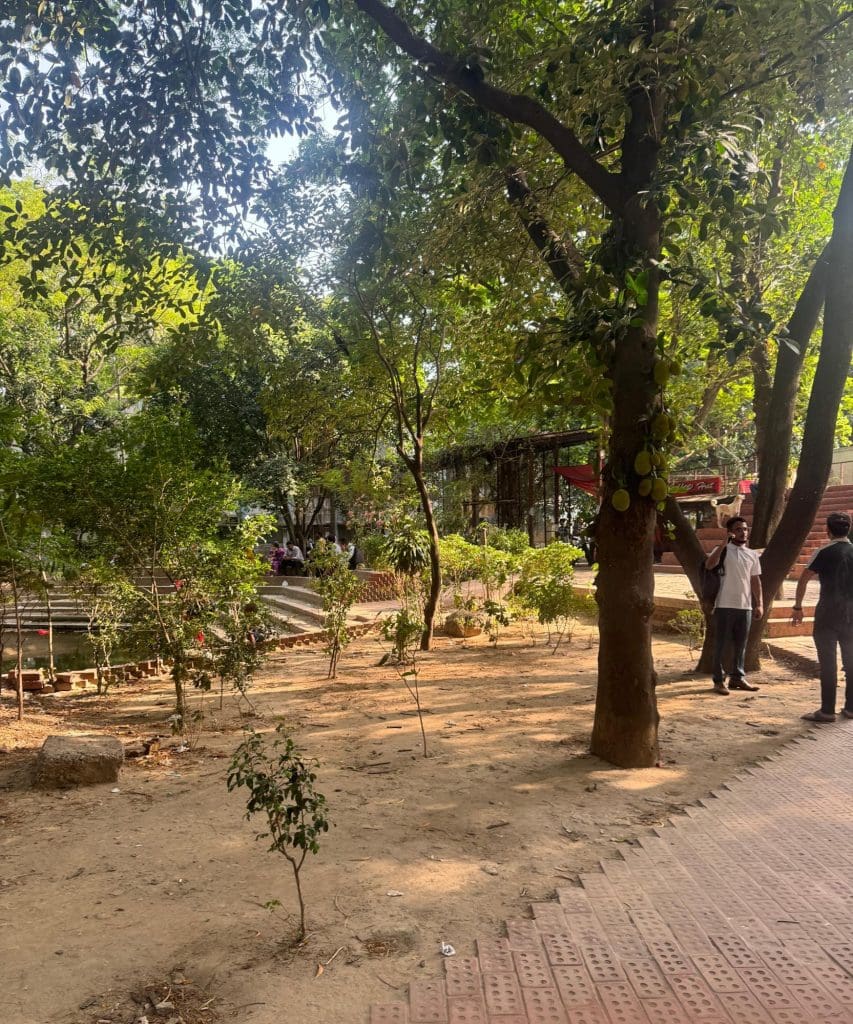
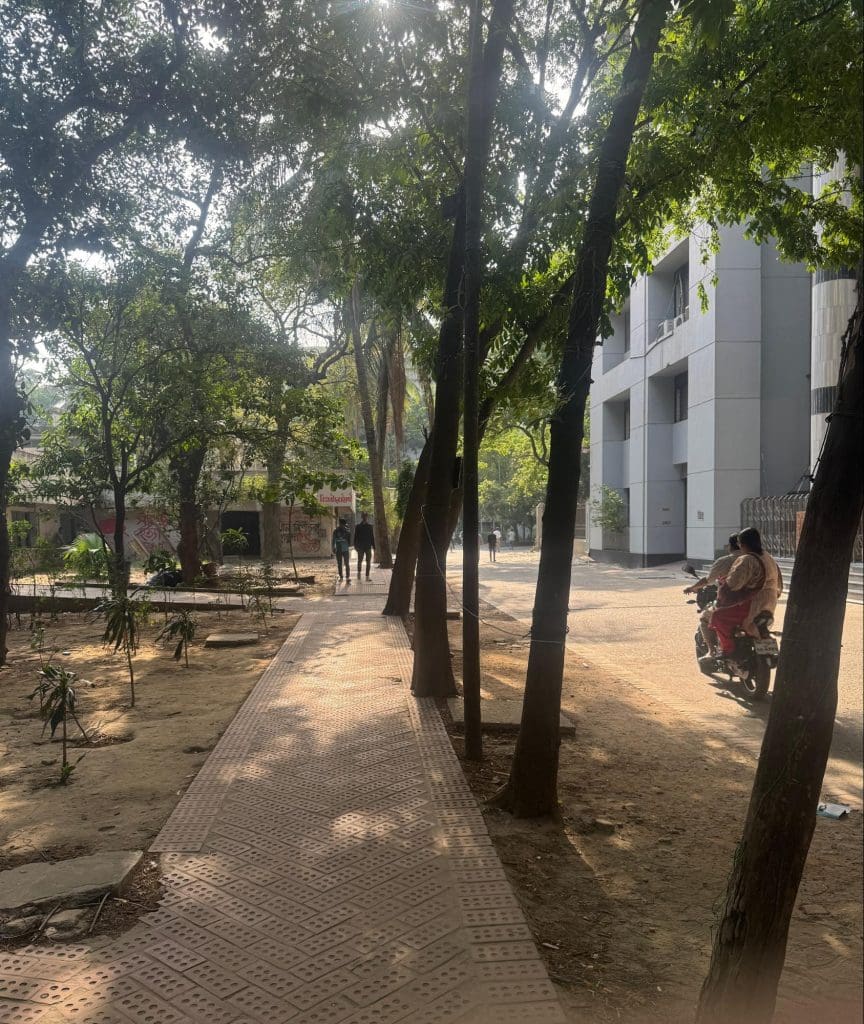
Faculty of Social Sciences, University of Dhaka (Photo: Shah Adaan Uzzaman/The Confluence)
To realize the substantial impact of trees in relieving people by just providing shade and air, observe the following 2 pictures taken in front of the Faculty of Social Sciences (FSS), University of Dhaka. The sunlight would have directly affected the pedestrians, especially students on this road if trees were not there to provide shed. Students often sit in this area, even in daylight as this place has trees which provide both air and shed.
So far we have positioned our tree army for public spaces where the government has the authority to intervene. However, a vast majority of areas are private authorities where authorities cannot directly plant trees. Certainly, awareness and education is key to make people informed and make them interested in planting trees and gardening. But we have reached a tipping point where heat waves are not only making people sick but also hijacking their lives. What more can we do?
Sustainable & Green Architecture and Design
Walls, building facades and roofs of buildings can be transformed into green spaces. Green Walls and Green Roofs are widely used in many buildings across the world to cool their establishments. The Chicago City Hall’s green roof has lowered roof surface temperatures drastically. These sky gardens on the rooftops of high-rises provide relief to the people inside the buildings during extreme heat, coupled with benefits of beautification.
The Oasia Hotel Downtown in Singapore features a vertical garden that covers its façade, acting as a living skin that cools the building. This living tower has a red mesh facade that is covered in 21 different plants. The total area of plants on this high rise can replace over 10 times the greenery that was on the site prior to the construction of the hotel.

(Photo: Darren Soh)
Not just outdoor, greenery can also be increased indoor or inside the buildings. Singapore’s Changi Airport is an example of such exemplary architecture.

(Photo: Singapore Changi)
What can Bangladesh do to promote sustainable architecture?
- The Government of Bangladesh (GoB) can start with increasing greenery in the existing government buildings and establishments. Green roofs can easily be implemented in these high-rises, and even green walls are also possible to set up.
- GoB should revise the Bangladesh National Building Code (BNBC) and mandate the installation of green roofs and walls in both new and old buildings, both commercial and residential. A detailed guideline must be released by the GoB, with a joint collaboration of the Ministry of Housing and Public Works and Ministry of Environment, Forest, and Climate Change on the installation of vertical gardens and green rooftops.
- GoB can offer tax incentives for retrofitting existing buildings with green infrastructure.
- Awareness should be created by relevant agencies to inform people regarding the income-generating activities of rooftops as fruits, vegetables and flowers can be produced from the rooftop gardens. In the Bangladesh market, asking people to put effort into protecting the environment may not be appealing to a wider audience; however, showing them monetary benefits or ways to earn money can provide greater incentive to them.
District Cooling System
Ancient Persians built a network of underground pipes to circulate chilled water around their city in order to fight extreme heat. The Gardens by the Bay in Singapore uses perhaps the world’s largest underground district cooling system to keep the establishment cool. It uses a large central plant that cools water, and then uses underground pipes to send the chilled water to different buildings. It has reduced 40% electricity consumption compared to traditional ACs. Thanks In Stockholm, a district cooling system uses cold seawater from the Baltic Sea to cool buildings.
Recommendations
- Bangladesh should start undertaking massive district cooling system projects that can connect all the high-rises.
- To make the district cooling system financially feasible, the designated authorities can take a monthly bill or monthly subscription fee for this service.
- Integrating sustainable water management practices is critical in ensuring availability of water for such a large scale cooling system.
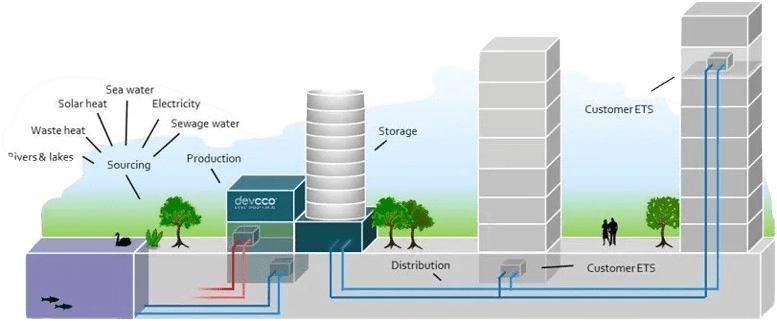
Reflective Building Materials
In Bangladesh, most high-rises do not contain reflective building materials that absorb more heat and reflect less sunlight, which in turn increases temperature inside the buildings. Using reflective materials is an ancient solution, used on Greek Islands to lower temperatures leveraging the “albedo effect”, which is the ability of surfaces to reflect sunlight. When surfaces are coated white, the temperature reduces significantly.
In several streets in Los Angeles, black asphalt has been covered with a white, reflective material. According to Greg Spotts, former Chief Sustainability Officer of StreetsLA with the City of Los Angeles, “In the late afternoon, right when people would come home from work, the street can be 10 degrees Fahrenheit cooler than it normally would be, meaning that it’s not throwing of heat into these neighboring buildings.” Athens also painted their streets white and witnessed temperatures drop by 7.2 degree Fahrenheit. The “CoolRoofs” initiative in New York City encourages building owners to install reflective roofing materials.
Recommendations
- Encouraging the use of high-albedo (reflectivity) materials in the construction of pavements, roads, and buildings is necessary to cool our cities. The Bangladesh National Building Code should be revised by mandating building owners to use reflective, heat-resistant materials in their buildings, especially on the roof surfaces.
- GoB can take the initiative to paint streets white in an effort to reduce temperature.
Further Recommendations
- Singapore has prepared a catalog of over 80 measures, named Strategies for Cooling Singapore to mitigate urban heat and improve outdoor thermal comfort. Drawing inspiration from countries like Singapore, the Government of Bangladesh can develop the “National Strategies for Cooling Bangladesh” to provide direction to the pertinent authorities.
- Under the ‘Cooling Singapore’ initiative, researchers are developing a Digital Urban Climate Twin (DUCT) to simulate and test urban design impacts on heat management, aiming for broader application in other cities. Such virtual models can be made for Bangladeshi cities to effectively manage heat.
- The government can establish Community Cooling Centers in public buildings like schools, community centers, equipped with necessary air conditioning and hydration stations to provide relief to the communities during extreme heat events.
- Labor laws in Bangladesh should also adapt with the extreme heat conditions. Construction workers and some other professionals have to work under extreme sunlight in risky conditions. Limiting their time outdoors while ensuring they are not working under specific hours during the day can be a step forward.
- Currently, street-shading is in high demand, especially from commuters and hawkers who seek shelter from the sun in passenger sheds at different bus stops. The number of such passenger sheds should be increased while ensuring safe drinking water facilities.
In the Dhaka Metro Rail, greenery is missing from everywhere. Metro Rail should be adorned with greenery while also making water available for the passengers or commuters. Currently, there aren’t any safe drinking water facilities available in the metro rail. Making drinking water accessible will provide relief to the urban commuters of Metro Rail. - Government-led wetland restoration projects, including the Hatirjheel Area Development Project are crucial stepping stones. GoB should focus on restoring such water bodies across the cities to cool our cities.
About the Author

Shah Adaan Uzzaman is the Blog Administrator at The Confluence. A former Bangladesh Television Debate Champion and winner of several policy & debate competitions, he is currently a student of IBA, University of Dhaka.
